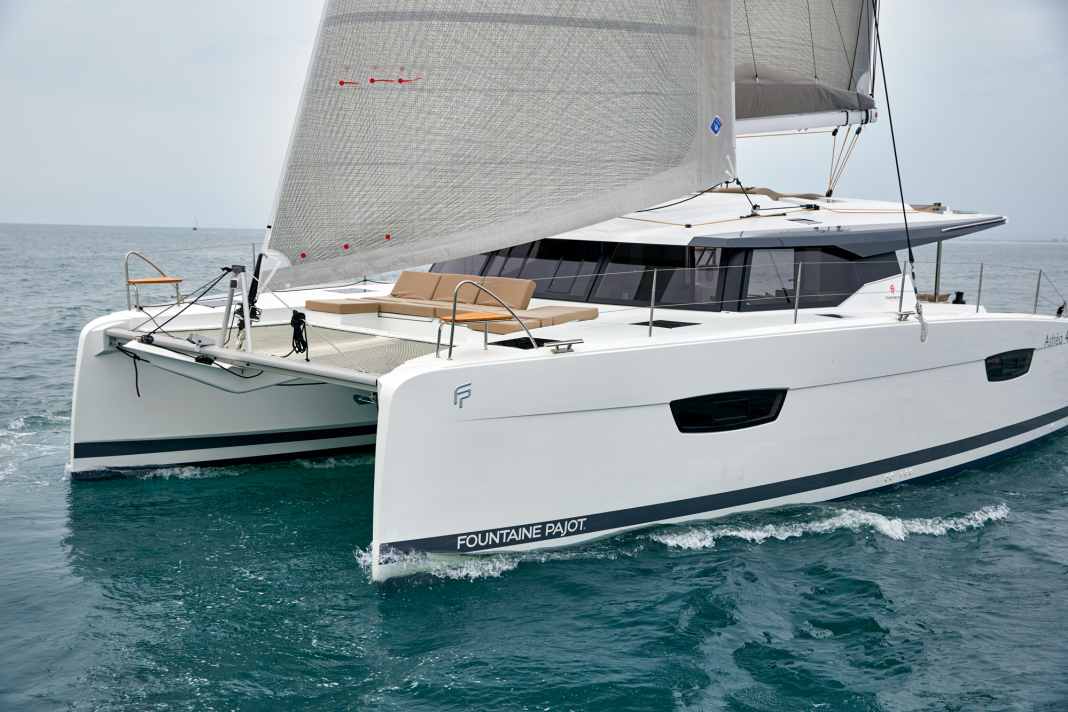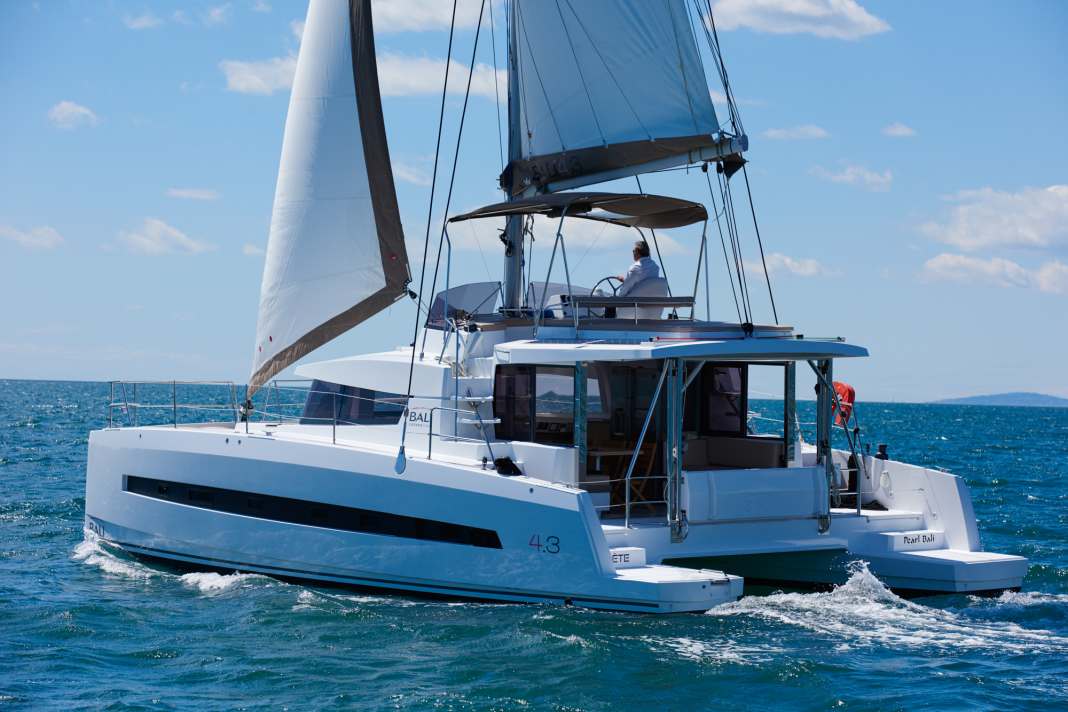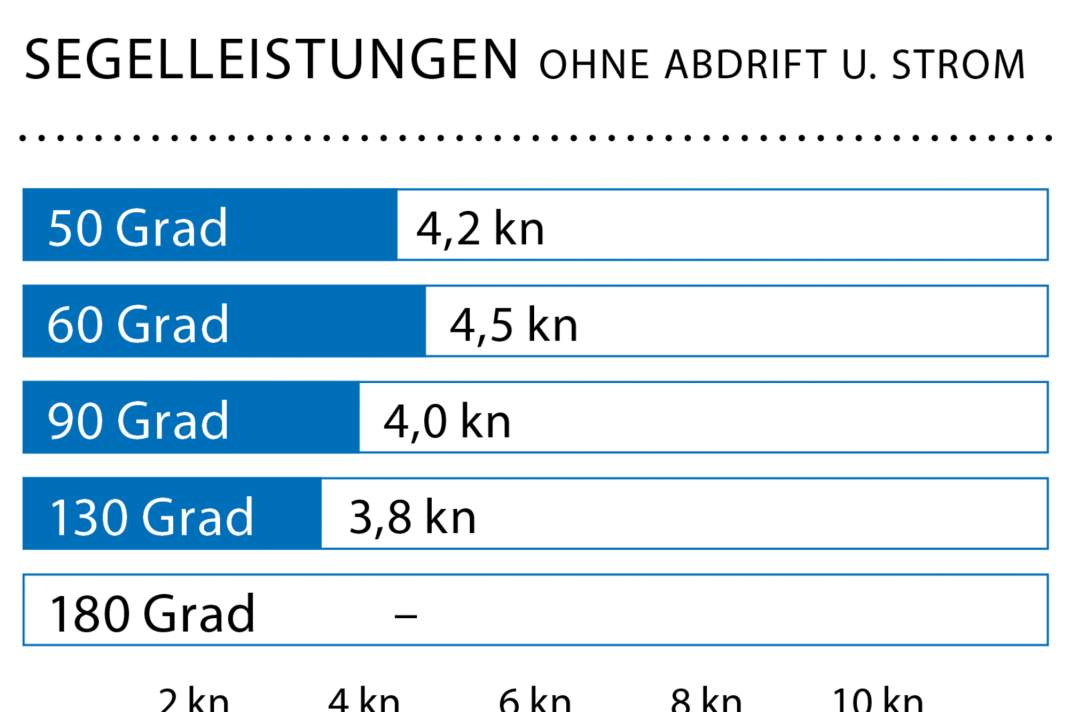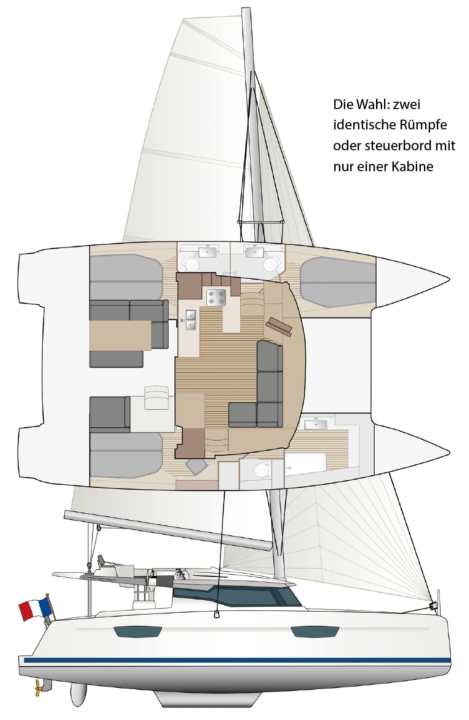





A curious fact: the 42-foot size, which is quite common in the monohull segment, is currently in short supply in the large-scale production cruising catamaran segment. In the length class of around twelve and a half metres, there was initially only the Bali 4.3, and then the 42-foot model from market leader Lagoon was added, later supplemented by the new 43, and that was it. The Astréa 42 from Fountaine Pajot fits seamlessly into the programme of the shipyard from Aigrefeuille near La Rochelle, which has been in existence since 1976. It recently launched the Lucia 40 (YACHT test in issue 16/2016) was launched as an entry-level model, followed by the Saona 47 (YACHT 10/17) and is running the Hélia 44, another medium-sized catamaran.
The competition of the Astréa 42



Insiders report that the global potential for new twin-hulls now amounts to 750 to 950 units per year. The shipyards are reacting: Lagoon, Fountaine Pajot and Outremer have expanded their capacities, while Bavaria Nautitech has modernised and increased its production. This is creating demand, and more and more monohull shipyards are securing a second mainstay with a catamaran programme. Lagoon belongs to the Beneteau Group, Nautitech to Bavaria, Hanse bought Privilège and has since sold it again.
Fountaine Pajot and Dufour
Fountaine Pajot went the other way round and took over Dufour, making this new group one of the top five shipyards in the world. FP has enjoyed good double-digit sales growth in the past.
Many boats, growing competition, new manufacturers characterise the entire market, which is now splitting further and where each brand is looking for its own identity. Fountaine Pajot has opted for a very independent design with a striking design language. Negative stems, i.e. retracted at the top, a negative deck step and an angular superstructure with a steering position halfway between the deck and the roof on the starboard side characterise the look. A sofa area awaits guests between the deckhouse and the trampoline; the shipyard has opted against deep, full-size front cockpits like on the Leopard or Bali boats.
Also interesting:
Fountaine Pajot also favours a sophisticated construction method for the weight-sensitive products. The hulls and decks are built using the vacuum infusion method and the roof using the injection method. The boat is equipped with stub keels, which are glued into boxes and are designed to fall off in the event of a hard grounding without damaging the hulls. The designers Berret/Racoupeau gave the new boat a lot of cloth: Around 100 square metres on the wind are significantly more propulsion than the competition offers.
A boat that wants to sail
A good measure, as was demonstrated off La Grand Motte in the Languedoc-Roussillon region, where the test took place after the Salon International du Multicoque, a pure multihull show with over 60 multihulls. In typically light winds and moderate temperatures that were unable to generate thermals, the Astréa 42 was surprisingly agile. With no more than seven knots of wind, 4.2 to 4.5 knots were feasible at the cross, and the boat steered comfortably, responded well to the rudder and also tacked sensibly without measures such as a genoa to be held back.
The test boat was equipped with the upmarket D4 membrane from Incidences Sails, whose profiling and features made an excellent impression. The expected positive effects of the Axon carbon mast on the test boat, by far the largest extra item on the accessories list, could not be verified in view of the low wind and smooth water.
The rower sits on a bench that offers space for two people. With a diameter of 70 centimetres, his tool is quite small and only requires one and a quarter turns from stop to stop. Power is transmitted from the wheel to the starboard rudder via Bowden cables. The two blades are connected by a push rod. Measured against the long distances and many connections, the steering system still works with very little play and directly.
Halyards and sheets run centrally through cleats on three sufficiently large Lewmar winches, which are positioned on the roof in front of the helmsman. They cannot be reached from the wheel, but are operated from a standing position, which is an excellent ergonomic solution as the arms work at a good angle and height. As the cat can sometimes travel a long distance in a straight line without a person at the wheel, separating the two working areas is not a problem even without an autopilot.
The all-round visibility from the helm station is excellent, only the port stern can be seen through a bow. When manoeuvring and underway in the harbour, it is advisable to stand next to the throttle levers on deck, from where there is excellent visual contact with all four corners of the catamaran.
Three steps higher up on the cabin roof, there is a padded sunbathing area for two measuring 2.00 by 1.40 metres, which you have to cross to reach the boom, which is installed at a good height for folding the sail. What would still be desirable, however, is a simpler access option from the front via the roof; there is no ladder or individual steps.
Saildrives behind the leaves
Under the four-seater sofa in front of the superstructure, whose waterproof and well-fixed cushions can remain in place while travelling, there is a huge storage space, as is usual on many cats. This can accommodate water tanks, an optional watermaker, fenders or folding bikes. The anchor windlass and chain locker are also installed there, which is easier to operate and, above all, centres the weight. Additional storage space is provided by the bow tips, from which the Code Zero or gennaker can be set directly.
Also worth mentioning on deck are the exemplary walkability thanks to the large surfaces and flush hatches, the roof, which provides a little shade because it has an overhang, and the stern platforms, which protrude over the hull, making it easier to board the boat lying alongside. Instead of davits, a bathing platform is optionally available (at extra cost), which also serves as a dinghy holder and can be lowered electrically to below the water surface.
The engines, whose saildrives still protrude into the water behind the rudder blades, are installed as far aft as possible. As the catamaran under the engine is only controlled by the propellers, the fins do not need to be exposed to air. And the aft installation makes it possible to install the engines completely isolated from the living area in terms of heat, odour and acoustics and within easy reach.
Which could also be measured. The optional 40 hp Volvo Penta engines (standard are 30 hp) emitted only 68 db(A) in the aft chamber, but 73 db(A) in the cockpit, which is still within the normal range. Also nice: there is plenty of space around the engines for the installation of other equipment, which can also be easily inspected there.
The cockpit as a living room
The cockpit offers a spacious seating area for eight people, a sofa and a bench seat, plus plenty of walk-in space and a permanently installed outdoor grill as well as the option of installing an additional refrigerator. The fixed roof provides shade and, if desired, light and music.
The deck saloon is accessed via a large sliding door with no difference in level, while the mighty U-shaped galley is adjacent to the cockpit. Those working at the cooker or work surface can enjoy social distancing and a perfect all-round view, as can the navigator at his angled table, from which the boat can also be steered on autopilot in bad weather. There is an inner seating area for colder days; here the owner can choose between a small coffee table or a dining table that can be lowered. This would create a double berth in the saloon, which would be particularly welcome on long journeys, as it means that the lifeguard is quickly on hand if required.
With the saloon berth, there would be a maximum of ten berths on board, an occupancy that you will not want to realise. The Astréa 42 is available in two versions: In the Quator version, the hulls are mirrored and feature four comparably sized cabins, with a choice of different heads compartment configurations. The Maestro version retains the port hull, but modifies the starboard side to form the owner's area. The hull can be separated from the deckhouse by a sliding door. The space is divided between an open aft cabin, a desk and dressing table, plenty of cupboard space, including in the passageway, a separate toilet room and an almost princely bathroom with plenty of storage space in the foredeck. All in all, there is almost an abundance of cupboards and drawers. However, shelves on the forward berths would be desirable.
The ventilation could also be optimised. Thankfully, small windows in the large panoramic windows can be opened in all cabins and, in combination with the deck hatches, provide cross ventilation. However, opening rear windows would be an additional option, at least aft. The surfaces are visually and haptically pleasing, the ceilings and side panelling are less plasticky than on the manufacturer's previous boats. The visible finish is also essentially successful and corresponds to large-scale production standards as known from monohull shipyards. However, there is no choice of colour scheme. The furniture is light, the floors dark, the work surfaces grey, the skies light and grey-brown. Options are available for the exterior floors: The cockpit and the sterns can be optionally covered with real or artificial teak.
Living on the water
The extra list of technical equipment, on the other hand, is exceptionally large and includes items that you would expect as standard, such as a lazy bag, cockpit table or deck shower. This is surprising, as the price of the boat is significantly higher than its direct competitors. On the plus side, however, it boasts an upmarket design, a neat finish, good sailing characteristics, a convincing layout, many different usable outdoor areas, well thought-out and ample storage space - in short, a harmonious overall package.
Another good thing is that it can already be equipped for the long voyage at the shipyard. For example, the installation of electric winches, microwave, washing machine, dishwasher, watermaker, air conditioning and solar panels has been prepared and calculated. With the possible full equipment, the boat offers standard household living comfort, with up to four bedrooms and four bathrooms as well as a kitchen-living room and three terraces; the swimming pool is also always included. And the whole thing sails too.
The modular bathroom

Ingenious: there are three options for the central wet rooms - two identical WC rooms with access to a shower in between (above); one larger and one smaller bathroom and two medium-sized wet rooms, each with a partition wall. This applies to both hulls in the charter version. Each cabin has its own bathroom
The measured values for testing the Astréa 42





The Astréa 42 in detail

Technical data of the Astréa 42
- Designer: Berret/Racoupeau
- CE design category: A
- Torso length: 12,58 m
- Total length: 13,43 m
- Waterline length: 12,58 m
- Width: 7,20 m
- Depth: 1,25 m
- Mast height above waterline: 20,60 m
- Mainsail: 65,0 m2
- Furling genoa: 41,0 m2
- Weight: 11,5 t
- Machine (Volvo): 2 x 22 kW/30 hp
- Fuel tank: 470 l
- Fresh water tank: 2 x 350 litres
- Holding tank: 2 x 90 litres
Hull and deck construction
Hull made of GRP sandwich with balsa core, manufactured using the vacuum infusion process with partial use of vinyl ester resins. Deck and flybridge made of GRP foam sandwich (injection). Keel hooks made of GRP in keel boxes
Price and shipyard
- Base price ex shipyard: 619,990 euros, gross incl. 19% VAT, as of 6/2024
- Standard equipment included: Engine, sheets, railing, navigation lights, battery, compass, cushions, galley/cooker, bilge pump, toilet, sailcloth, anchor/chain, fenders, mooring lines, fire extinguisher, electric cooler, holding tank with suction
- Guarantee/against osmosis: 2/2 years
Shipyard
www.fountaine-pajot.com, La Rochelle/France
Distribution
Dealer network
YACHT review of the Astréa 42
Can do everything a catamaran has to do, and do it very well. Comfort, space on several levels and storage space are in perfect harmony with good sailing characteristics and pleasant handling. What's more, the dynamic lines should appeal to many potential buyers
Design and concept
- + All-round view of saloon and steering position
- + Very large living space
- + Plenty of deck storage space
Sailing performance and trim
- + Comparatively agile in light winds
- + Good steering feel
- + Convenient to operate
Living and finishing quality
- + Successful room layout
- + Bright and airy in the saloon and hulls
- - Forward berths quite narrow
- - Unsealed hatch cover edges
Equipment and technology
- + High-quality equipment
- + Various useful options
The article first appeared in YACHT 12/2018 and has been updated for the online version.

